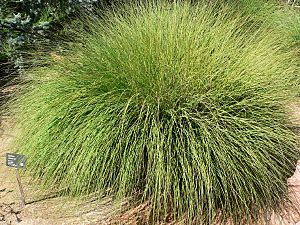Deergrass facts for kids
Quick facts for kids Deergrass |
|
|---|---|
 |
|
| Scientific classification | |
| Genus: |
Muhlenbergia
|
| Species: |
rigens
|
Muhlenbergia rigens, also known as deergrass, is a type of grass that grows in clumps. It's a "warm season perennial bunchgrass," which means it grows best in warm weather and comes back year after year. You can find it in sandy or well-drained soils. It lives in the Southwestern United States and parts of Mexico, usually below 7,000 feet (about 2,130 meters) in elevation.
Contents
What Deergrass Looks Like
Deergrass has thick clumps of narrow, pointed leaves at its base. These leaves can grow up to about 3 feet (1 meter) long. Their color can be light silver-green or even purple. The stems, which look like spikes, are less than half an inch wide. They can reach lengths of 3 to 4 feet (about 1 to 1.2 meters).
When the plant blooms, it grows many flowers on tall stalks called panicles. These stalks can reach heights of 5 feet (about 1.5 meters)! Each tiny flower part, called a spikelet, has one floret without a bristly tip.
Where Deergrass Grows
This grass naturally grows from Shasta County, California, in the north, all the way south into New Mexico, Texas, and Mexico. It can live in many different types of places. These include open grasslands, areas near rivers (riparian areas), and chaparral (shrubland). It also grows in forests with mixed pine trees or oak trees.
Deergrass can handle areas that flood sometimes. However, it doesn't like standing water or soil that stays wet and doesn't drain well. It prefers lots of sunshine but can also grow in shady spots.
How Deergrass Helps People and Animals
Young deergrass shoots are eaten by different animals. But as the plant gets older, animals don't like to eat it as much. This makes it a good plant for gardens if you want to keep deer from eating it!
Deergrass is also very useful for stopping erosion (when soil washes away). Its strong, deep roots help hold the soil in place. It's used to stabilize riverbanks and restore land. People use deergrass to replace invasive plants that are taking over natural grasslands. It can also help fix farm fields where the soil has been damaged. It adds back important organic matter to the soil.
Scientists have studied deergrass to see if it can clean up chemicals from farm runoff. Its thick clumps and deep roots act like a natural filter. They can help break down herbicides, pesticides, and other tiny particles.
Deergrass is also important for animals. It provides cover for mule deer, especially when they are having their fawns. Young shoots and leaves are eaten by deer, horses, and cattle. Many types of butterflies and moths (Lepidoptera) and ladybugs use deergrass as a place to live during winter. The seeds of deergrass are also a food source for many different kinds of birds.
Deergrass and Native American History
Deergrass was very important to many Native American tribes. They used its long, straight seed stalks to make beautiful coiled baskets. Each basket could need over 3,000 stalks!
Because of this, many California tribes actually grew deergrass. They would regularly burn areas to help the deergrass grow better. This burning also encouraged the plants to produce the long, straight stalks needed for basket making. It's believed that much of where deergrass grows today is because Native Americans helped it spread.
Growing Deergrass
Muhlenbergia rigens can be planted in late spring and early summer. You can spread the seeds and water them. For the best results, about 50 seeds per square foot are planted. They are then lightly covered with soil. It grows best when steps are taken to reduce weed growth. This might include burning, tilling, or using less fertilizer to reduce weed seeds in the soil.
Planting deergrass in containers is also a very good way to grow it. Seeds can be planted in trays in May and then moved to the ground in the fall of the same year. In California, you can plant deergrass in winter and spring to use the seasonal rain. This is true unless there is a lot of frost.
Once deergrass is established, it doesn't need much care. You usually don't need to water it in years with normal rainfall. Adding fertilizer is not recommended because it can make weeds grow more. Every few years, you can burn or mow the plant to remove old, dead parts.
Deergrass is special because it uses a process called C4 carbon fixation. This helps it grow well in dry and hot conditions. Because of this, and its attractive look, it's now popular as an ornamental plant in xeriscape gardens. These gardens use plants that need very little water. Studies also show that deergrass can handle salty conditions. This means it might be watered with recycled wastewater at a low cost.
Images for kids


